Gymnastic Riding
A true connection with the horse
Gymnastic riding is the art of bringing the horse's movement into balance with the rider's postural influence.
It opens the door to a whole new connection with the horse, one that speaks a universal language of true relevance to horses - the language of balanced and empowered motion. This language transcends the divisions between riding disciplines, and is therefore relevant to any kind of rider.
Normal riding, in the majority of riding disciplines, seeks to control the horse's actions using the reins and the legs, often with the help of various bits, spurs and the whip. Although it is often rudimentary, this kind of communication with the horse can become very sophisticated, as the horse becomes conditioned to respond in certain ways to subtle signals. However, it is fundamentally NOT the same kind of interaction as gymnastic riding, which is first and foremost a physical, biomechanical connection.
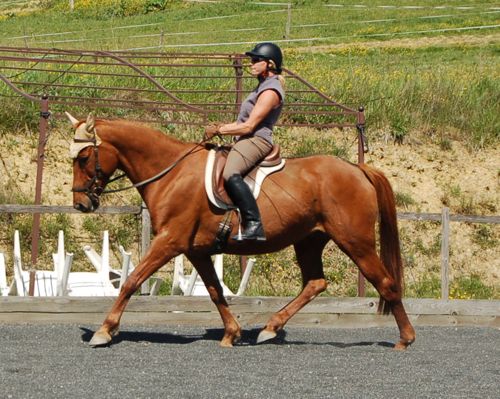
In Gymnastic Riding, the rider develops their posture in a particular way so that each part of their body helps to channel the horse's body into alignment and promote optimal transmission of the horse's energy from the haunches through to the front end.
The whole mechanism of the rider's body becomes profoundly connected to the mechanism of the horse's body. This closes the gap in communication between signal and response that is always present with other forms of riding.
How Can We Influence the Horse's Balance?
Although many riding disciplines, in particular dressage, set out to improve the the horse's balance and agility, this can only be done in a truly effective way using a postural connection, because this is the only way we can truly change the horse's natural imbalances.
When the rider 'plugs-in' posturally to the horse's body, the depth and continuity of the connection allows the rider firstly to feel the way the energy of motion is transmitted though the horse's body, and secondly to address any ways in which energy is being lost - for example, misalignment and blockages of any sort.
It is only this postural connection developed in Gymnastic Riding that can allow the rider to 'get inside' the horse's body in this way, and to transcend the approximation that is inevitable in any other kind of riding connection.
More on exactly what this postural connection involves later in the article, first let's look at the reasons for putting the effort into riding in this way.
Why Gymnastic Riding?
Re-balancing The Horse - The Rider's Duty
Horses have adapted their own way of balancing in movement over millions
of years of evolution. Naturally, they use their bodies in a way that
balances energy efficiency with minimal strain on the joints.
Five important characteristics of the horse's natural balance are:
- More weight is carried on the forehand (the front limbs) which has a stabilising role, while the hindlimbs having a more propulsive role.
- Horses naturally bend to the outside while turning instead of flexing their body in alignment with the direction of motion.
- Horses tend to raise their head and hollow (drop) their back momentarily each stride, and sometimes on a continual basis.
- The biomechanics of the horse's natural way of moving include significant lateral rotation of the ribcage (rolling side-to-side) each stride.
- All horses are naturally uneven - their bodies are naturally flexed more to either the left or the right.
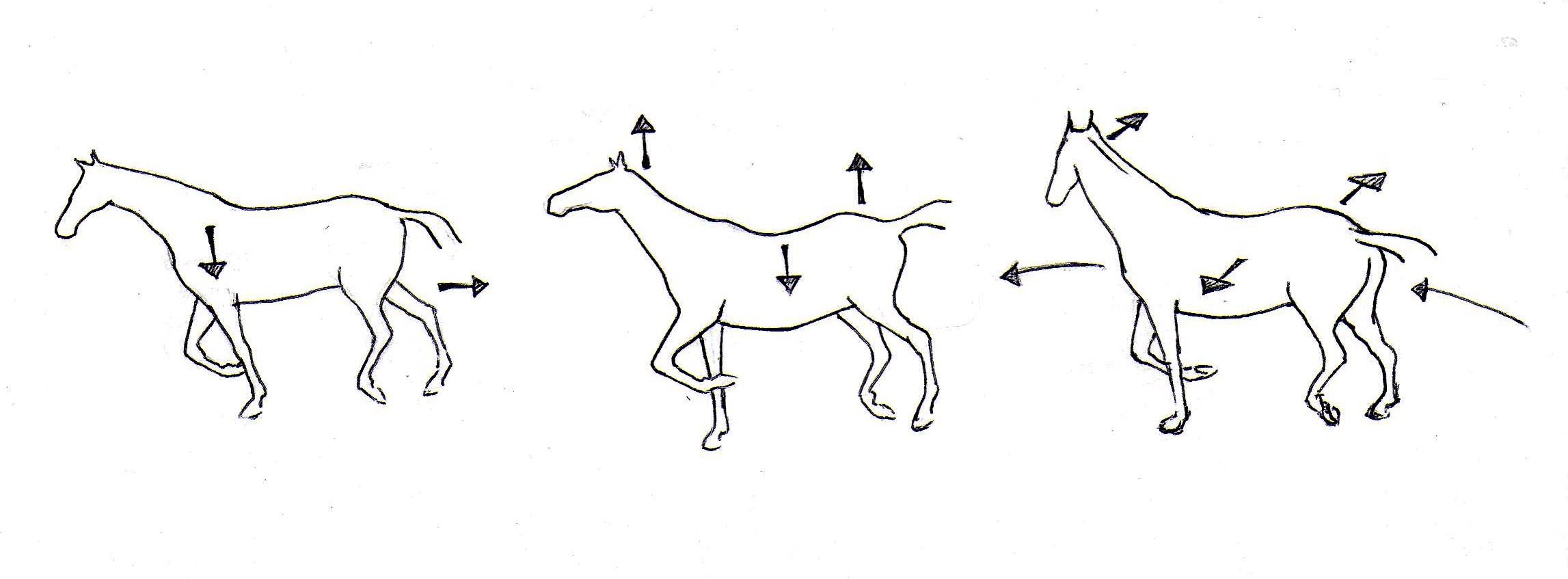 Three of the horse's natural characteristics of movement: weighting of the forehand, intermittent hollowing and counter-bending
Three of the horse's natural characteristics of movement: weighting of the forehand, intermittent hollowing and counter-bendingThese characteristics demand our consideration because, with the addition of a rider on the horse's back, they ALL lead to lack of balance, loss of transmission of energy, and long-term physical damage.
When we sit on a horse, we interfere with their natural balance in a profound way. When the horse continues to balance in their in-built way with a rider on-board, considerable strain is put on the spine and the limbs. Natural misalignment and crookedness which are absorbed by the horse's natural balance without a rider, become accentuated under the rider's weight and constant demands.
In order for the horse to support the imposition of the rider, we need to show them a different way of carrying their body altogether. The basis of this alternative is postural engagement.
Postural Engagement
The Secret to Balanced Motion in Riding
The postural 'ring' of muscles creates a system of support for the whole spine, keeping it lifted under the rider's weight like a suspension bridge. This protects the vertebrae and connective tissues from compression and eventual damage.
Engagement on the postural ring also draws the hindlegs further under the body mass, allowing the horse to carry more weight on the haunches, and less on the forehand. This is very important for carrying a rider in balance, as too much weight on the forehand causes rushed movement, strain on the forelimbs, resistance in the rein contact, and lack of maneuverability.
The alignment of the horses body (also referred to as 'straightness') is also vital to the horse carrying the rider in balance and comfort. There is a very close relationship between postural engagement and straightness. On one hand, the horse has to be aligned to a sufficient degree for the postural ring to be able to engage in the first place, and once the horse is working consistently in engagement, the ring itself becomes a powerful force that draws the horse (and rider) gradually towards straightness.
Force and Conditioning:
The Alternatives to Gymnastic Riding
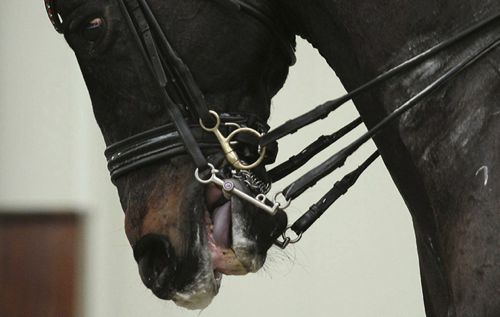 An extreme example of forceful riding, but there are many more subtle, less obvious degrees of force that are used commonly in all riding disciplines.
An extreme example of forceful riding, but there are many more subtle, less obvious degrees of force that are used commonly in all riding disciplines.Unfortunately, the majority of riders, even in educated circles of dressage riding, are unaware of how to create postural engagement in the horse, and they often try to deal with natural imbalances when they get to the front end.
Some don't agree with the very existence of the postural ring, but this is understandable, because it's perfectly possible to ride horses for an entire lifetime without ever feeling true engagement. It is such a particular and unique phenomenon that it is never something one just stumbles upon. Although many riders may feel glimpses of engagement - those magical moments of unity with the horse - if they do not pursue it, and follow the process of developing their body in the necessary way to achieve it, they may never realize that it is a whole different realm from normal riding, or the 'short-cuts' of spurs and double-bridles.
This video shows the reality of the forceful use of the bit.
The bit is so often used to block too much forward movement, to attempt to 'lift the horse up in front', to 'get the horse to come round', and to compensate for lack of alignment in the horse's body. However, all of this is only papering over the cracks - once an imbalance has reached the horse's mouth, it is TOO LATE for the rider to do anything meaningful about it.
Compensating for imbalances with the bit only fixes them more into place, and further stifles the flow of energy coming through the horse's body from the haunches. Holding onto the reins in order to either keep your own balance or to attempt to control the horse's balance in any way is detrimental to the horse both physically and psychologically.
The Importance of Learning to Let Go
One of the most essential principles of Gymnastic Riding is that the rider must let go of the fixation on controlling the horse's direction, speed, balance and posture with the bit in order to 1) connect to the horse's body in a different way, and 2) open the door for the energy to be channeled through the horse's body from behind.
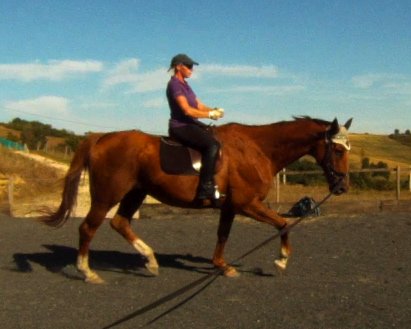
Gymnastic riders must learn to stop holding on to the reins, and start plugging-in to the horse's body with their seat, legs and posture. For this reason, an apprenticeship of riding on the lunge, with no reins to hold onto, along with correct instruction on the position, is the ideal first step in the process of learning this way of riding.
How Can The Rider's Posture Bring A Horse Into Balance?
Next to the power of the horse, the human being is a weak little thing. How can we hope to influence the powerful forces of the horse's movement with our posture alone? Especially when we are sitting onto of his back with no external fulcrum of support!
The way we do this is similar to the way a master of martial arts may easily repel an opponent many times bigger and more muscular.
The power of the posture is in its connectivity. Postural strength is about creating power in the connective tissues, which gives a tensile quality to the structure of the body. This tensile quality is necessary for any transmission of energy though the body's structure.
Examples of how Energy is Transmitted Through Tensile Structures:
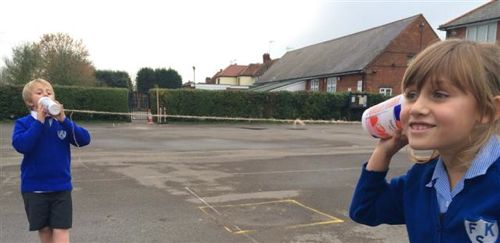 The String Telephone
The String Telephone- When children communicate through two yoghurt pots connected to each end of a long string, the sound is only transmitted when the string is taught, not when it's slack.
- If two people are holding a skipping rope, and one wants to send a wave through the rope to reach the other person, it won't work if the rope is completely slack.
- An archer can only transmit power into an arrow when the bow is brought into tensile flexion.
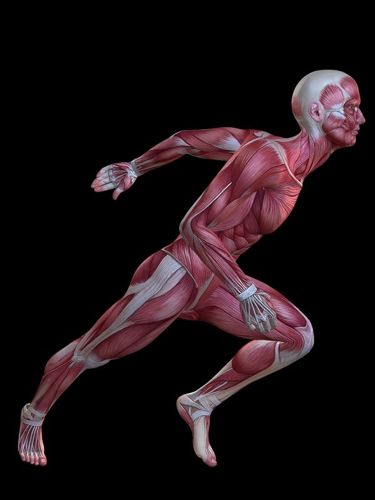
- A sprinter propels their body forward powerfully as they push off the ground because their strong postural cohesion is channeling the energy into forward motion, not allowing any of it to be absorbed and lost in unnecessary movements of the body.
The unusual task of the rider is to be able to connect to another large body or movement, and then to create a tensile quality in their own posture, which, by means of the adhesive connection of the seat, reaches through into the horse's body, and connects to the power of the horse's movement.
The movement becomes channeled by the tensile connection of the rider's posture, and this triggers the horse's own postural system to come into engagement.
The postural ring holds the spine in a consistent tensile stretch, so that energy can be transmitted through it from the propulsive hindlegs, towards the front end, just like the sound waves going through the string from one yoghurt pot to the other. This is the true meaning of the horse being 'through'.
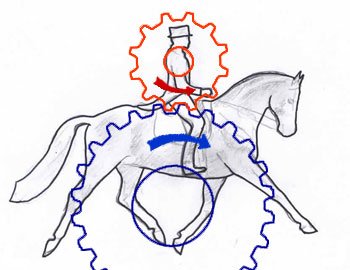
The whole thing becomes a powerful mechanism for recycling and transmitting energy, very much like the gear system in a bicycle or a car.
Connectivity, Not Tension!
It is easy to confuse the use of the word 'tensile' in relation to the posture with 'tension', but they are not the same at all. Gymnastic riding is not at all about either horse or rider becoming tense - in fact it's the very opposite, relaxation on a profound level is a prerequisite for a postural interaction to take place - much like a martial arts master is profoundly calm and centered in order to be able to channel their energy precisely and powerfully. Connective tissues cannot store and transmit energy if there is too much muscular tension interfering. This is partly why HHT puts so much emphasis on the horse's lifestyle promoting calm and relaxation as a foundation for training.
The Balance of Postural Leverage and Adhesive Harmony
The tensile quality of the posture is simply a way of creating the leverage necessary to bring powerful unbalanced forces of motion into balance.
The rider can only create this postural interaction when they have first created a very harmonious connection with the horse through the adhesive seat: a way of developing the seat that allows it to become totally unified with the horse's movement.
It's like we have to first plug the socket into the wall, then the voltage (a kind of tensile quality on an electromagnetic level) can connect and turn on the appliance. The rider plugs into the horse with a harmonious, adhesive seat, and then the cohesive posture can connect through to the horse's movement and influence his own way of carrying himself.
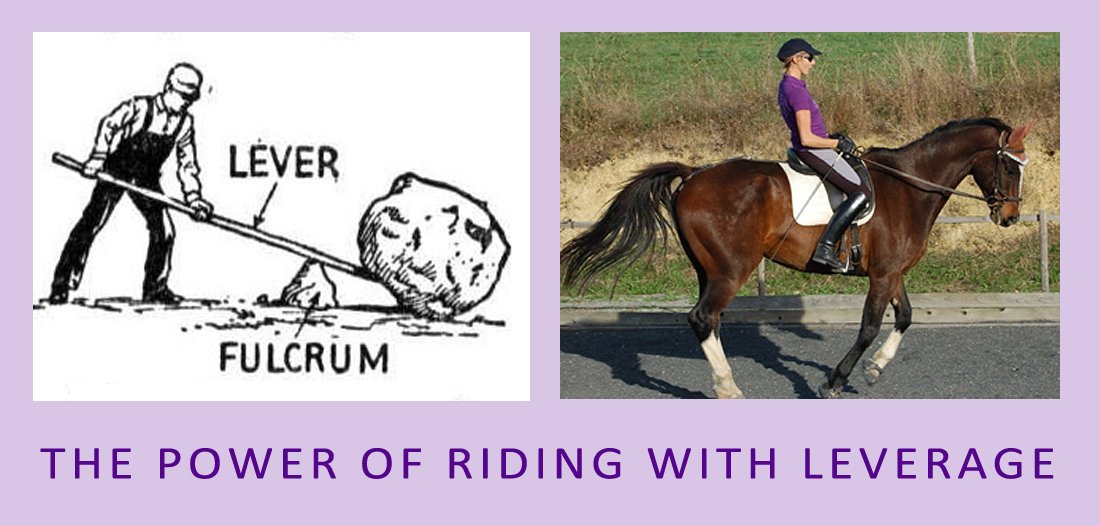
You could also imagine that you wanted to move a heavy stone using the leverage of a stick - the stick has to have a good, stable connection with the stone before you can apply the leverage that will shift it. In riding, the connection is the adhesive seat, connecting to the energy of the hindlegs, and the leverage is the postural connectivity.
How The Postural Ring Channels and Amplifies Power
The engagement of the horse's postural ring means that each time a hindleg pushes off the ground, there is a postural resistance in the horse's body, that sucks that energy through from the hindleg into the horse's body, amplifying its power and sending it through the horse's spine.
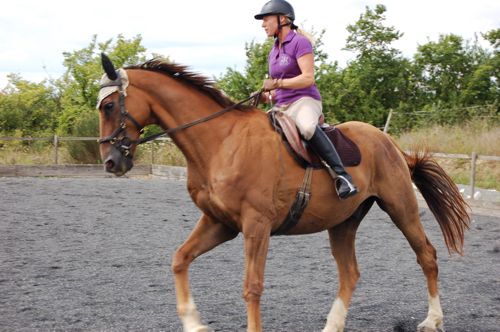
This postural resistance acts like a spring, so that after each hindleg
has stretched the spring by pushing out behind, when it then steps
forwards, the spring recoils and creates a stronger, bigger step
forwards. When the horse steps further under his body mass from behind,
his spine can lift more easily and support the rider's weight better,
and this lift creates a natural softening into the bridle as the whole
spine becomes 'round'.
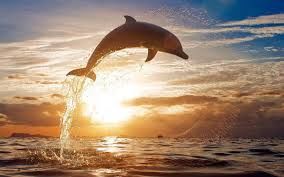
Dr. Deb Bennett, an expert on horse anatomy, conformation and biomechanics, and who developed the concept of the ring of postural muscles in the horse, has stated that Dolphins and Whales posses a similar postural ring dynamic as that of the horse working in engagement (see her excellent book Principles of Conformation Analysis).
This mechanism could well be the reason that dolphins can generate extraordinary speed and power when they swim and leap in the water.
Interestingly, a long-standing mystery has surrounding this very subject, named 'Gray's Paradox', since 1936 when the scientist Sir James Grey conducted studies that showed that a dolphin's muscle mass is not sufficient to generate the power and speed that they are capable of producing when swimming.
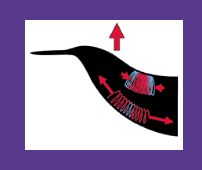
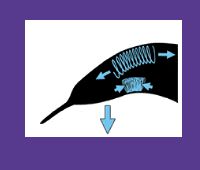
Recent studies have shown that dolphins use their tail like a postural spring, to store and release energy which propels them through the water. It has been found that they can generate massive propulsive forces with each flip of their tail fluke (see this article).
There are theories that this is due to their ability to store energy in connective tissues that connect the tail to the spine. It seems likely that dolphins are in fact using a whole-body postural ring of muscles in order to amplify the propulsion of their tail action, just like the way an engaged horse amplifies the energy generated by the thrust of each hindleg.
It is interesting that these recent studies are linking the dolphin's power to energy stored in the connective tissues, as this is the secret to the postural torque used to channel energy in gymnastic riding.
Imagine if a dolphin let their belly flop down when their tail pushes back - they wouldn't generate much power! This is what happens when a horse carries a rider without postural engagement - their back drops each time a hindleg pushes off. Even though the horse succeeds in sending his body forwards in relation to the ground, there is little transmission of energy through the structure of the body, so much of the power of propulsion is lost.
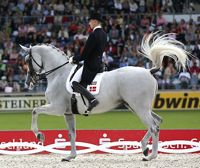 Despite her popularity, this horse displayed a particularly dropped back and disengaged haunches, and the resulting loss of purity in the gaits is clear.
Despite her popularity, this horse displayed a particularly dropped back and disengaged haunches, and the resulting loss of purity in the gaits is clear.Without transmission, there is no power or grace with which to lift the rider, and there is an unpleasant feeling of disconnection between the haunches and the front end.
The equivalent to this loss of postural leverage in the rider's body is if they let their pelvis drop down onto the pubic bone each time the horse's hindlegs are pushing off, allowing their abdomen to stretch and push forwards. When the rider allows this to happen, it also allows and encourages the horse to drop their belly and back, eliminating the support of postural engagement on the ring.
The rider's pelvic orientation is crucial in the postural influence they have over the horse. If we sit in the way the horse's movement naturally places us (and unfortunately the way that riders are usually taught to sit), then we will encourage the horse to drop his back instead of lifting it.
In fact there is always a beautiful mirroring dynamic between the horse's and rider's bodies. Whether this mirroring is good or bad comes down to whether we choose to let ourselves mirror the horse's natural imbalances, or whether we create a new dynamic of balance in our own body, and allow the horse to mirror that.
 Particularly good stepping under from this little Lipizzaner mare, who has been rehabilitated from severe hollowness and postural weakness
Particularly good stepping under from this little Lipizzaner mare, who has been rehabilitated from severe hollowness and postural weaknessOnce a rider achieves the phenomenon of postural engagement to any degree, they are usually hooked from that point on, because no other sensation on horseback can compare to the magnificent feeling of plugging into this channeled power.
The Rewards of Gymnastic Riding
Bringing the horse into balance for carrying a rider is not only protective and therapeutic for the horse, it is also greatly fulfilling and enjoyable for the rider on many levels. On the level of sensation alone, even a basic mastery of a postural, adhesive connection with the horse makes riding so much more comfortable and enjoyable.
When the rider becomes able to create consistent engagement, the sensation of channeled power is wonderful, and incomparable to ordinary riding. The rider feels their weight is lifted by the supporting hindlegs and stretched spine, instead of being dropped onto the forehand with a sagging spine.
Gymnastic riding is as therapeutic for the rider as it is for the horse - it promotes a strong postural core, and a supple spine that does not get concussed by the horse's movement. The hip joints and sacroiliacs become much more loose and supple, and the rider's own unevenness is gradually addressed as they correct their interaction with the horse.
If a rider has the determination to follow the process of transforming their body over many years, they will reach a point where the posture becomes easy to assume and feels natural. They will be able to achieve consistent postural engagement with any horse that is physically and mentally able to do so, instead of managing only fleeting, elusive moments of this unique sensation.
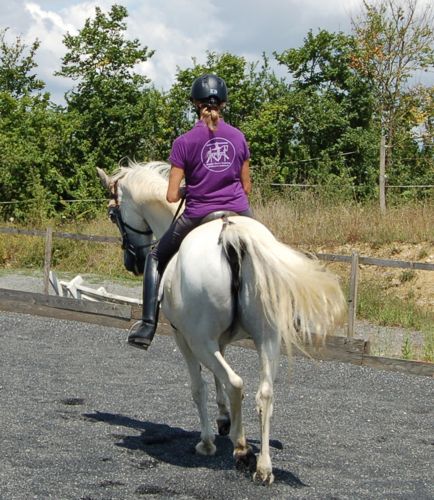 This horse, like many we have worked with, has recovered from serious unsoundness thanks to the healing power of gymnastic riding, combined with a holistic lifestyle
This horse, like many we have worked with, has recovered from serious unsoundness thanks to the healing power of gymnastic riding, combined with a holistic lifestyleWhen, in turn, the horse is trained in postural engagement over several years, they will transform on many levels, becoming increasingly powerful, supple and capable of diversity of movement within balance. Their work will also provide them with a deeply healing inner calm and reassurance - the only way that a human can really replace the security of the herd in a horse's mind.
Is Gymnastic Riding The Same As Dressage?
Our passion for riding is rooted in dressage, but we have chosen to adhere so strongly to certain ideals of dressage concerning the quality of the movement, that we have been led away from the usual practice of dressage - whether 'competitive', 'classical' or any other school.
The fundamental difference between gymnastic riding and the vast majority of dressage riding is that gymnastic dressage is guided by feel, with the goal of improving quality of movement, whereas most traditional dressage is guided by the process of training certain movements, with the goal of achieving precision and increasing complexity of their performance, along with a particular outer appearance of the horse and rider. One is based on the inner, and the other on the outer.
When any rider is working with a horse, they are faced with choices continuously, and they are forced to prioritize. For example, we may choose we want to do a certain exercise, which requires performing a particular figure, but we also must choose how we ask the horse to do this, and whether the quality of the horse's balance and transmission during the exercise is more important than, for example the precision of the figure performed, or the promptness of the horse's response to our demand.
As soon as we start to prioritize the appearance of what we do over the feeling of how the horse does it, we start choosing to ignore the quality of the horse's balance and transmission, and we start prioritizing precision, 'obedience', learned responses and so on. In order to do this, we start having to use more forceful control with the reins, spurs, whip etc, along with increasing mental conditioning of the horse.
This is the great pitfall of dressage riding.
We may succeed in creating a 'pleasing' appearance, and produce an 'impressive' performance, but we will have lost the whole essence and meaning of dressage - the magical feeling of balanced, unrestrained motion.
If we choose to prioritize the feeling of the horse moving in balance and alignment when we ride, through our postural connection, then we will be led to use whatever exercises are appropriate in each moment with a particular horse.
Training becomes an organic, intuitive process, instead of rigid conditioning. It may take years before we achieve precision of performance that is genuinely based on perfectly balanced, aligned movement.
Some horses, due to their individual limitations, will never be able reach a high level of dressage performance when they are trained in this way, because the physical demands of engagement are so high that a certain level of natural suppleness and good conformation is required for the highest level of work, within postural engagement (of course, any horse can be trained to do the high-level movements with trick training, where there is no postural engagement).
All horses can, however, benefit from an improved quality of movement (transmission, alignment, evenness, suppleness, and balance) when trained in postural engagement.
This is the difference of gymnastic dressage: whatever level of training they reach, an ordinary horse will have the quality of their movement enhanced, and a talented horse can have the quality of their movement elevated to a sublime level.
In appearance-based dressage, ordinary and talented horses alike will have the quality of their natural gaits gradually diminished over time, even though they may be trained (conditioned) to perform advanced movements with accuracy.
The constant blocking of their movement by the rider seeking control through the bit, the misalignment of natural crookedness which is not addressed, and the overall wear of carrying a rider without postural support and lift, stiffen the joints throughout the body and corrupt the purity of the gaits. The injuries sustained by many dressage horses by the end of their career is proof of the damaging effects of this way of riding. It is only gymnastic riding and postural engagement that can protect the horse from this.
Most dressage puts the level of performance achieved first, and the gymnastic value of the work is very often sacrificed.
Every rider must make this simple choice: whether to put their feel first, or the appearance of what they do. There is no half-way-house - the feeling of truly balanced movement is so difficult to achieve that if we let other concerns start to creep into our attention, we are sure to lose our way on the path towards gymnastic purity.
The choice we make has a lot to do with how much we rely on the recognition of others, or how much we are open to follow a more internal path of discovery.
If you are someone who is attracted to dressage, or riding in general, by it's aesthetic qualities, then there are three major reasons you may be put off gymnastic riding, or told by others that it is incorrect:
- Firstly the posture in the horse that is necessary for postural engagement to develop is unappealing to many, because the horse needs to work in a long, low, stretched frame at first, and be given the time to become more elevated in front slowly - some horses, due to their conformation, will never develop a high head-carriage when they are engaged. Equally, the appearance of the rider's position is different from that which is traditionally accepted, especially during the early stages of the rider's gymnastic development.
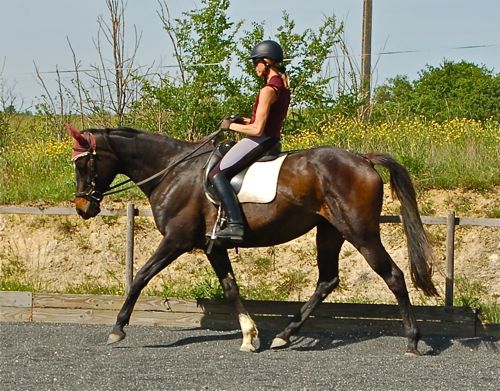 This is an ex-racehorse, who is working in good engagement, but due to her conformation, her 'outline' will never take on the 'advanced' appearance of a horse with more uphill dressage conformation
This is an ex-racehorse, who is working in good engagement, but due to her conformation, her 'outline' will never take on the 'advanced' appearance of a horse with more uphill dressage conformation- Secondly, the precision of the horse's execution of our demands must be allowed to develop slowly, as the horse becomes more gymnastically able. Precision is not something we can demand, especially at lower levels of training. The gymnastic rider must always be willing to wait until the moment is right, or to accept less execution in order to prioritize higher quality. This makes performing dressage tests complicated until the horse has a high level of gymnastic ability, because precision is demanded even at the most basic level.
- Thirdly, overall, gymnastic training is a much slower process than training based on mental conditioning (for which horses have a natural aptitude), so ambitious setting of goals is not helpful, as every horse and rider have their own individual rate of progression. Setting out to reshape the horse's natural balance, which has evolved over millennia, is a great challenge, and it must be given all the time it takes. With good riding, the horse will live a longer, healthier life, so the rewards for patience are always reaped in the end.
Gymnastic Riding Embraces Mind, Body and Spirit
Riding well is not just about a physical process of development. It also requires that we develop ourselves on a conscious level. Whether or not we are aware of this aspect of ourselves, when we start down the path of creating a gymnastic connection with the horse, developing our own body and that of the horse's in the right way, we will inevitably be faced with a series of challenges that require us to form our character and evolve on a conscious level.
First, there is the basic challenge of developing concentration and mental discipline.
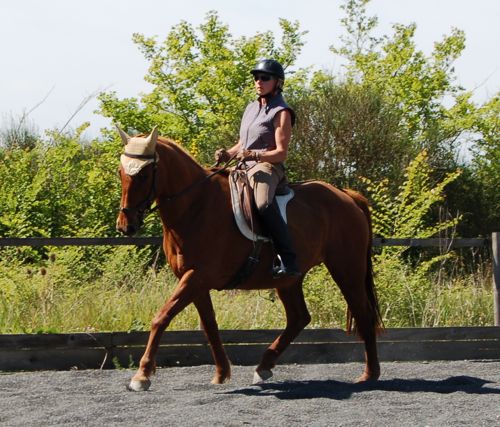 Every session of gymnastic riding is like a meditation in communion with the horse
Every session of gymnastic riding is like a meditation in communion with the horseFrom this foundation, we can start to develop a heightened awareness of our body and that of the horse's, beyond the level of our everyday perception.
In addition to these mental challenges, we will be continuously faced with our ego in its many forms.
Of course, one of the biggest obstacles to the gymnastic rider is the temptation of seeking external recognition. This can come in many forms - from anyone who judges us externally, but also from our own choice to value ourselves on the basis of external goals.
Seeking recognition will always lead us away from the development of feel.
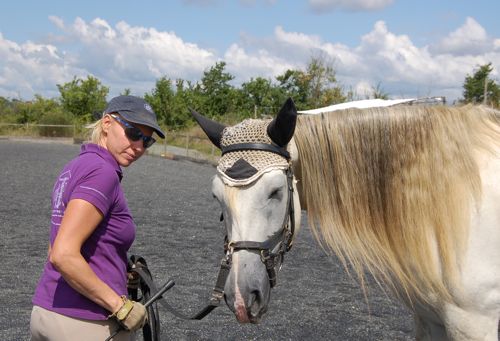
Riding and working with horses provides us with a wonderful opportunity to develop true honesty, humility, patience and compassion. There are constant opportunities to recognize the destructiveness of the frustration we feel when our expectations are not met, and to learn the power of always staying in the present moment, accepting the process as it unwinds, and realising our power to manifest the state we choose in unison with the horse.
If this description of gymnastic riding inspires you, HHT has a full, in-depth guide to how to go about riding with the posture: The Gymnastic Rider eBook. Click on the link for more information.
Return from Gymnastic Riding to the Happy Horse Training homepage
The pages on HHT are so wide-ranging and interrelated that we strongly recommend you look at the site plan to find other subjects that may interest you.
New from HHT!
AudioRide is a series of exercises designed to listen to while you ride.
Audio descriptions guide you through each step of developing a balanced, dynamic connection with the horse through your position.
This truly innovative learning tool gives you a whole new way of being guided in your riding, in a calm, clear, step-by-step way.
Free Download! Introductory Exercise: Riding in the Now
The Gymnastic Rider eBook
Now available exclusively from HHT!
A unique, comprehensive guide to practical rider biomechanics. This professionally produced eBook takes the rider through the process of developing their body in the specific way that brings the horse's movement into harmony and balance, without force and constraint. Click here for full details, and to download the 15-page introduction to the book for free.
Join the Happy Horse Training group on Facebook!
See and share topical info, news and photo's, and take part in lively discussions.
Click here to go to the HHT group (make sure you log into fb first) and then click on the 'join' button at the top of the page.
Join the Whole Horse Newsletter!
HHT's free monthly newsletter giving you wide-ranging and intelligent insights into holistic horsemanship.
Just enter your details below to join.
Free bonus on the riding position with all new subscriptions: Ten Top Tips To Instantly Improve Your Connection With Your Horse.
Click here to see back issues of The Whole Horse newsletter
Train Your Horse
The Holistic Way
How To Train A Horse Without Force
is a unique guide to training horses through energetic connection and
gymnastic training. Part 1 covers everything on the ground, from
handling to the lungeing technique that develops strength, straightness
and engagement. Comes with a free eBook supplement on Horse Trauma.
Click here for more details.
"As a student of Zen Buddhism for nearly three decades, I've often wondered when someone was going to write the book on Zen and the art of horsemanship, and I think that your emphasis on mindfulness and energy connection gets right at the heart of the matter."
- Prof. Teresa Lloyd, U.S.
Do You Have
A Horse Story
To Share On HHT?
So many people have been through
wonderful experiences with horses, whether in training or otherwise. If
you've made a change in a horse's life - or one has made a change in
yours - tell us about it here.
Learn The Natural Barefoot Trim - The Simple Way
The Simple Seven-Step Natural Trim is a comprehensive step-by-step guide to a cutting-edge barefoot trim. Click here to find out more.
What people say about HHT:
"The riding instruction is outstanding, if instructors in the UK taught this way there would be a lot of happy riders and horses."
"The riding tuition exceeded my hopes and expectations by a long way; giving me an exciting new facet to horsemanship which is lighter. more subtle, more elegant and more meaningful. It is as if a new door has opened bringing more sunlight and air."
"My goodness - what a change has taken place in my riding. I think that I'm starting to sit 'into' the horse rather than on top of him. I felt my horse's movements in a way that has almost never happened before"
Click on Testimonials for more
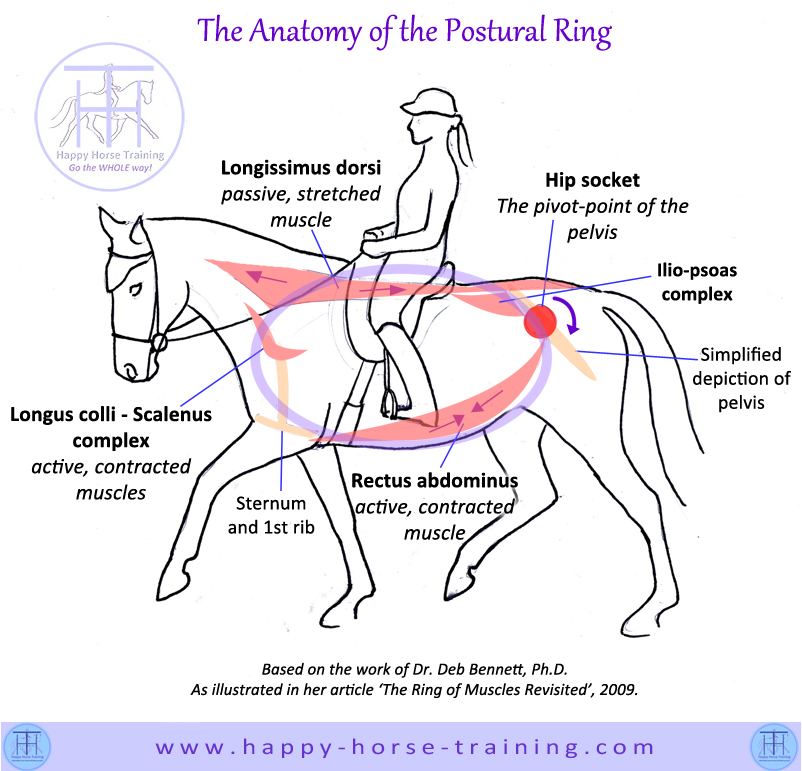
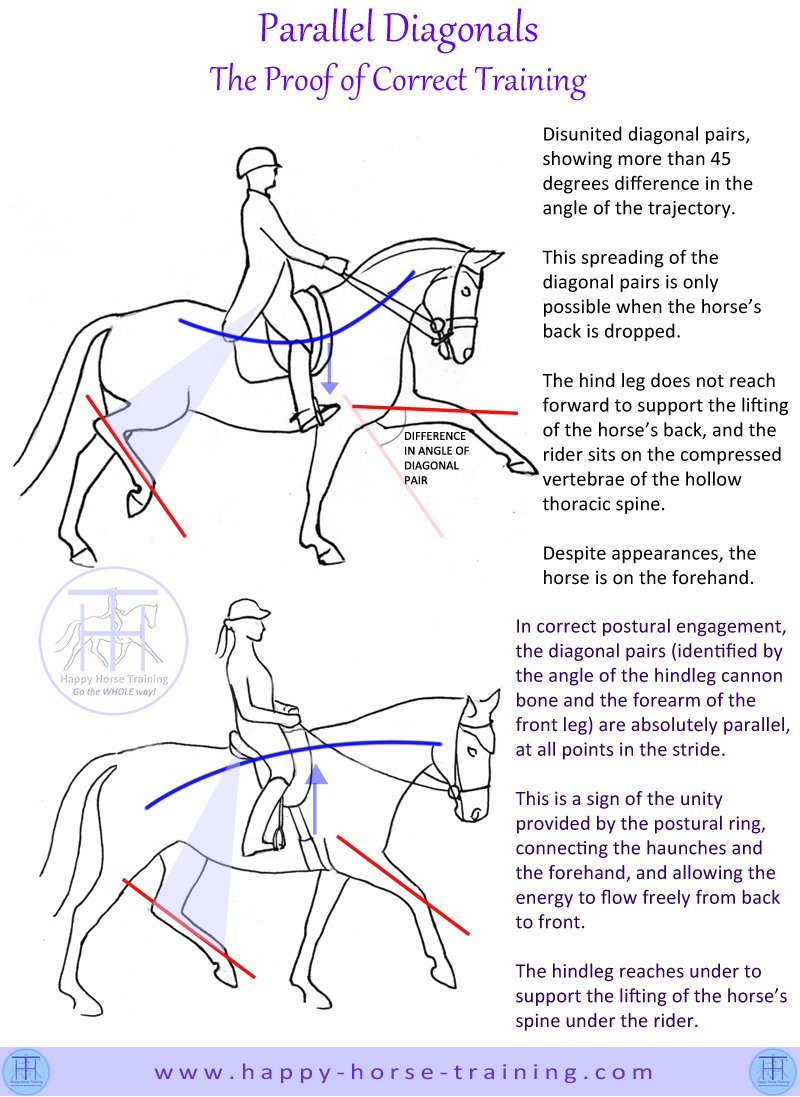





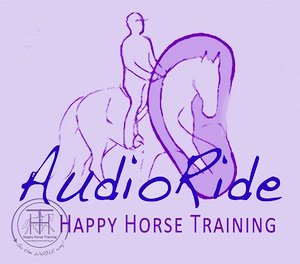




New! Comments
Anything to say about this page? Leave your comment in the box below.